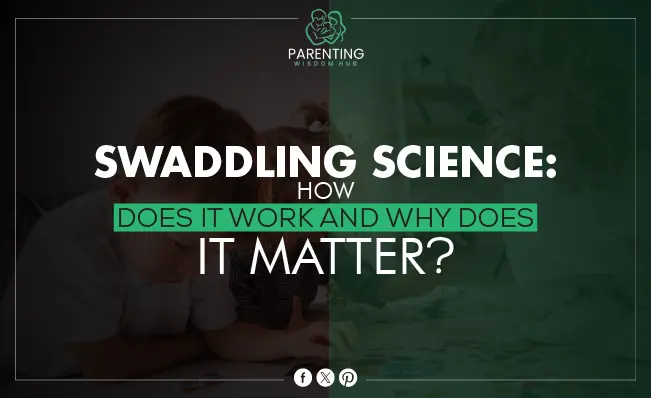Introduction
Swaddling babies has been a traditional way to care for them for hundreds of years, and parents respect it because it makes babies feel so calm. Putting a baby in a blanket or cloth and wrapping it up quickly quiets a fussy baby. But what is behind this act that seems so simple? It’s interesting to look into the science behind swaddling because it can help us understand and care for babies more completely.
Swaddling is more than just a way to keep a baby warm; it’s an art form that makes them feel like they are in the womb. This detailed guide goes into great depth about swaddling, including its benefits, the science behind it, the different ways to do it, and when it might be time to stop this age-old practice.
If you want to learn more about how to care for a baby, read our blog post with a step-by-step walkthrough.
Histological Origins from Different Cultures and Evolution Over Time
Swaddling babies has roots in many countries around the world, which shows that it is universally recognized as a way to comfort and care for babies:
Ancient Egypt:
In this culture, babies were wrapped in cloth bands like mummies. The goal was not only to comfort people physically but also to protect their spirits.
Medieval Europe:
Swaddling became popular in Europe in the Middle Ages, though records from the 14th century show that it had been done before. Swaddling babies in cloth bands was thought to help shape their bodies and keep them from becoming deformed.
Native American cultures:
Different groups used swaddling as a way to raise their children. For example, the Navajo people used a cradleboard to wrap their babies to keep them safe and comfortable while letting the mother move around.
Asian cultures:
Wrapping babies in a blanket was seen as teaching them to be polite by keeping them still and calm in some Asian cultures.
Modern times:
These days, wrapping is seen as a soothing method that helps babies feel better and sleep better. It is now customary to use swaddle blankets and sleep sacks made just for that purpose. This shows how swaddling has changed over time.
What is Swaddling?
It is the traditional practice of closely covering an infant in a blanket or cloth to restrict limb movement. Swaddling has many benefits, but its main advantage is imitating the womb’s comfort. It is thought to calm newborns and prevent startle reflex wake-ups, improving sleep. Swaddling can also help colicky newborns and lower the incidence of Sudden Infant Death Syndrome (SIDS) by keeping babies on their backs.
Importance of Understanding Swaddling for New Parents
New parents need to know about wrapping and why it’s a good idea for several reasons:
Soothing Effect:
Swaddling helps babies feel safe and calm when upset or overstimulated by making them feel like they are back in the safe and comforting surroundings of the womb.
Promotes Better Sleep:
Swaddling helps babies sleep longer and better because it keeps them from moving independently, which could wake them up.
Reduces Colic:
Swaddling can help ease colic pain by putting light pressure on the baby’s belly.
Mitigates Risk of SIDS:
If you do it right, swaddling can help keep your baby on their back while they sleep, which can help avoid SIDS.
However, it is essential to learn the correct way to swaddle a baby so that the baby stays safe and cozy. Swaddling babies wrong can cause problems like hip dysplasia and getting too hot. Knowing when to stop swaddling them is essential as kids grow and develop.
Benefits of Swaddling
Besides making a baby feel calm right away, swaddling has many other benefits that help their physical and mental growth. Let’s take a closer look at these benefits.
Promotes Better Sleep
Swaddling babies helps them sleep better and for more extended amounts of time. By stopping the startle response, which can wake up a sleeping baby, swaddling ensures they get the uninterrupted rest they need to grow and develop.
Reduces Startle Reflex
Critics call it the “startle reflex” or “Moro reflex.” Babies have this reaction when they feel something falling or changing quickly. Tightly swaddling reduces this reaction, which keeps babies from waking up during sleep for no reason.
Mimics the Womb Environment
The snug fit of a good swaddle makes babies feel like they are still in the womb, which is familiar and comfortable. This feeling of safety is significant, especially in the early stages of growth outside the womb.
Calms and Soothes Babies
The limited movement and pressure of wrapping calm babies down in a way that I didn’t expect. Wrapping can be just as soothing for a baby as being held. It makes them feel safe, which calms their nervous system.
The Science Behind Swaddling
Many physical and mental parts of a baby’s development are changed by swaddling. Now, let’s look at how this old method works so well.
Neurological Development
The atmosphere inside the womb is wonderfully tight. When babies are swaddled, the gentle pressure from the tightness can help develop the vestibular system. This can help them keep their balance and get better at moving their bodies.
Regulation of Body Temperature
Since babies are still very young and can’t fully control their body temperature, wrapping helps them stay warm. If you do it right, wrapping can keep your baby at the right temperature, essential for their growth.
Impact on Sleep Patterns
Swaddled babies are less likely to startle, making them more likely to fall asleep quickly and deeply. In turn, this helps the child sleep longer, which is good for both the kid and the parents.
Psychological Comfort
In the first few months of life, when babies are still getting used to their new surroundings, swaddling helps them feel safe and secure. When babies are swaddled, they feel less anxious and stressed, which makes them happier.
How to Swaddle Safely
When done right, wrapping is helpful, but there are some critical safety issues to remember.
Step-by-Step Guide to Swaddling
Lay the blanket in a diamond pattern, fold the top corner to produce a straight edge, and arrange the infant with shoulders just above the fold. Tuck one corner over the body and fold or gather the excess cloth for a snug fit. On the other side, tuck the blanket’s bottom beneath the baby’s feet or legs.
Tips for Proper Positioning and Snugness
Ensuring the swaddle is tight and safe without being too tight is essential for its effectiveness. Even though the blanket should fit close, there should still be enough space around the hips for good joint growth.
Safety Precautions
Never swaddle a hot infant or one with extended hips. Overheating can cause Sudden Infant Death Syndrome (SIDS), and poor swaddling can cause hip dysplasia, a loose or dislocated hip joint.
Swaddling Techniques and Styles
Depending on their wants and comfort, there are different ways to swaddle your baby. Here are some well-known styles:
Traditional Swaddle
This is the traditional way to wrap a baby in a blanket so that their arms and legs are safe and can’t move. It is the most popular and flexible way to swaddle.
Arms Up Swaddle
With this method, the baby can have their arms at their sides or close to their face. It’s perfect for self-soothing because it lets your arms move around.
Sleep Sack Swaddle
Swaddle sacks are wearable blankets that zip up and offer all the benefits of traditional swaddling without a blanket. Parents who want a swaddle without the hassle of folding are fans of it.
When to Stop Swaddling
Knowing when to stop is as important as safely wrapping your baby in a blanket.
Signs of Readiness to Transition Out of Swaddling
Keep an eye on how your baby grows and changes. It would be best if you stopped covering them when they start to show signs of being able to roll over. This happens to most babies between 2 and 4 months but can happen to any kid.
Alternative Sleep Solutions
When your baby is old enough to no longer need to be swaddled, you can try other ways to help them sleep, like sleep sacks, light blankets, or just putting them down in a onesie. Also, now is an excellent time to work on sleep training and making a pattern for going to bed.
Conclusion
Swaddling goes beyond draping a blanket around a baby—it’s a profound link to our need for protection and comfort. Swaddling can give your kid the peace they need in these early years if you understand its subtleties and benefits. As caretakers, we must notice and support traditions that help our children grow and be happy. New parents should try this strategy and learn about swaddling for a comfortable, tranquil start to their baby’s existence.


